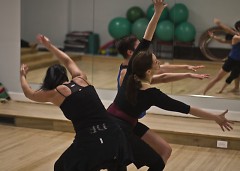Laura Armenta, founder of Laura Armenta Dance Company, has been bringing contemporary and ethnic style dances to Grand Rapids since November 1993. Armenta also owns Armentality, a dance studio offering a variety of classes from beginner to advanced, located in the Grand Rapids Masonic Center.
“Armentality comes from my last name Armenta with a play on words. To do the things that I do, one must have the ‘mentality” she says. “While the company and the studio are two separate entities, they combine: always feeding the other. People that see me perform become my students then my students evolve and become my dancers.”
Her philosophy in teaching has been to learn what works best for each individual student and then apply those ideals to her classes.
While growing up in Mexico City, Armenta gained a unique history of learning dance. At age 12, she began training with a group of adults on a collegiate level at the same university of her older sister. At the time Armenta was the babysitter for her niece during the classes but the teachers urged her to join in because she was simply already there.
“I was able to jump into a technique that was advanced and [with] a group of people that were adults,” she says. With a strong base in athletics and body conditioning, dance came naturally. By age 15, Armenta was dancing professionally.
“When I discovered dance, the one thing that moved me and made me stick to it was that I had the physicality of the movement but I was able to express things from my life,” Armenta says. “Through dance I found a way to communicate without saying a word because I used to be very shy.”
“The way a normal dancer would develop is you’d go with your classmates about your age and you evolve into whatever should be,” she says. “With me from the very beginning I was the youngest, being able to witness professional training. It was the one thing that really made a difference for me.”
“I thought I knew everything and I was just rocking it [at age 21],” Armenta says. In the midst of her growing success Armenta endured a severe knee injury. The operation required a full open surgery, leaving a large reminder on the inside of her left leg. There were complications with the dance company, her insurance was cut and Armenta faced a major obstacle in her dance career.
“The whole tragedy taught me that I didn’t know everything, that I was not perfect and that I did not have everything figured out,” she said. “I went from super diva to holy crap, now what? It was a moment where I thought, do I really want to do this, is it worth it? And it was.”
Guided by the physical therapist at the hospital where she received her operation, Armenta was introduced to yoga to self heal her injury.
“Before I was able to move in any way, breathing was the one thing that brought me back. I gathered myself and understood the power of breathing. Breathe, be in it,” says Armenta.
Armenta says this has branded the type of classes and connection she builds with her studio and dance company. She teaches classes in a small and intimate setting, allowing her to know the students and gain an understanding of what is truly bringing them to the studio.
Armenta decides her sequence based on what is going to “be healing to the student,” she says. “You don’t come to do class, not talk to your neighbor next to you, pack your stuff and leave- there is no connection.” There is a sense of trust that is instilled with dance, she says, a trust that allows the student to open up to new experiences. Armenta makes this known in her studio.
“As far as me being a teacher I think that everyone at some point should experience the joy of dance. Dance as a way to be social, a way to find something that keeps you in shape and I think emotionally dance has a lot to help build self confidence to interaction with yourself,” Armenta says.
“I offer dance the same way I would offer pineapples and pears. It is up to you to take a bite of the pineapple and perhaps eat the entire pear,” she says. This is what she applies to her classes. With training in many disciplines she offers skills to students on a level that will cater their needs.
“I don’t want my students to fit the structure of a particular dance, rather, I fit my sequence based on who is in the class. If I have a lady who is 65 and ladies who are in their 20’s in the exact same space it's something that I am going to adapt so that everyone enjoys it and gets something out of the class,” says Armenta.
The Laura Armenta Dance Company is working to become a certified nonprofit, allowing more opportunities to attend festivals or performances and spread the experience of dance beyond the walls of her studio.
Armenta believes the brain’s ability to learn languages is the same way our bodies can learn a dance, and that those who think they can’t dance are the ones she would encourage to join a class and express themselves. Armenta's goal is to help her students capture a better understanding of themselves, gaining positive energy designed to last beyond the class.
The Rapidian, a program of the 501(c)3 nonprofit Community Media Center, relies on the community’s support to help cover the cost of training reporters and publishing content.
We need your help.
If each of our readers and content creators who values this community platform help support its creation and maintenance, The Rapidian can continue to educate and facilitate a conversation around issues for years to come.
Please support The Rapidian and make a contribution today.
